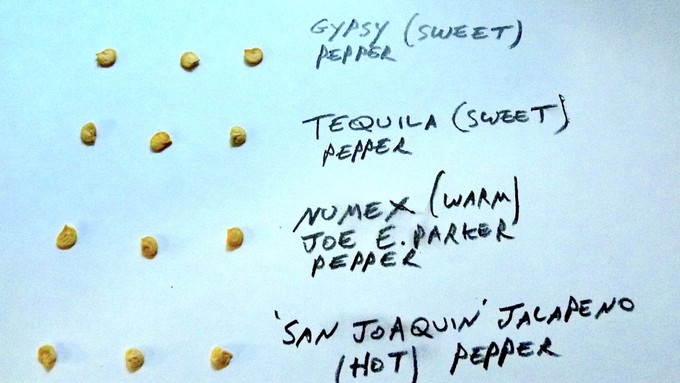
Possible varieties matched up with mislabeled jalapeños and purple bells; listen to podcast with Farmer Fred

Fred Hoffman created this chart to show how similar the seeds from very different peppers can look. Courtesy Fred Hoffman
It wasn’t just jalapeños that got mixed up in #jalapeñogate. Probably five pepper varieties distributed in at least 14 states were entangled in this seed distribution mess.
By now, most gardeners who bought jalapeños – or purple bells – have discovered whether they’re growing the pepper they thought they purchased. But thousands found out they did not.
Farmer Fred Hoffman and I chatted about #jalapeñogate during this week’s edition of his podcast, “Beyond the Garden Basics with Farmer Fred” – “Why Your Jalapeño Peppers May Not Be the Real Deal.” Listen to it here: https://gardenbasics.substack.com/p/jalapenogate?utm_source=substack&utm_medium=email#details
For his newsletter, Hofffman also recapped the #jalapeñogate saga and added his own experience. Pepper seeds tend to look alike, he noted. Also, online seed vendors may be suspect. Seed sleuths theorize the mislabeled seeds were imported from overseas, possibly China.
Peppers aren’t the only seeds that get mixed up; it can happen with all sorts of vegetables and flowers but rarely on such a scale.
Hoffman recalled, “A few years ago, I was on the hunt for a particular gaillardia, also known as blanketflower. The particular variety I was searching for was ‘Arizona Apricot.’ This red-yellow colorful perennial puts on its best show of daisy-like flowers in the summer.
“I finally found a source for this particular seed via Amazon. Imagine my surprise when the seed arrived, in a nondescript small plastic bag, labeled ‘Gaillardia seed from Qatar.’ Qatar? What the heck, let’s try it. When it blossomed the next summer, it was not ‘Arizona Apricot.’ Oh well, an inexpensive mistake on my part, shopping in a lightly regulated, online marketplace.
“But imagine this scenario playing out on a much larger scale: an American seed distributor who purchases seeds overseas for their clients here, which include home gardeners, wholesale and retail nurseries, as well as farmers growing particular varieties for restaurants and canneries. That is the current situation in the world of Jalapeño peppers – as well as a myriad of other vegetable and ornamental seeds – where seeds grown overseas were mixed up before shipment. And it’s only after the plants grown from those seeds started fruiting that the alarm bells went off.”
Hoffman noted research by John Porter of the University of Nebraska Cooperative Extension. Porter tentatively charted out the identities of what was planted and what they turned out to be. Plants labeled as green jalapeño cultivars were actually yellow ‘Caloro’ jalapeño hybrids. The ‘Tam’ jalapeño plants, a mild green variety, grew into sweet banana peppers.
Not only jalapeños were mislabeled. Hungarian sweet wax peppers turned out to be the bell pepper variety ‘Diamond.’ ‘Chocolate Beauty’ bell peppers were actually ‘Red Cherry’ peppers. And ‘Purple Beauty’ bells were Hungarian hot wax peppers.
So, some of the jalapenos actually were jalapeños – just not the variety on the label.
For more on Farmer Fred’s podcast and newsletter: http://www.farmerfred.com/.
How did your peppers grow this summer? Did you get what you expected? Did you have other garden surprises? Tell us. Email us at sacdigsgardening@gmail.com.
Comments
0 comments have been posted.Sacramento Digs Gardening to your inbox.
Sites We Like
Garden Checklist for week of May 5
Survey your garden after the May 4 rainstorm. Heavy rain and gusty winds can break the neck of large flowers such as roses. Also:
* Keep an eye on new transplants or seedlings; they could take a pounding from the rain.
* Watch out for powdery mildew. Warmth following moist conditions can cause this fungal disease to “bloom,” too. If you see a leaf that looks like it’s dusted with powdered sugar, snip it off.
* After the storm, start setting out tomato transplants, but wait on the peppers and eggplants (they want warmer nights). Pinch off any flowers on new transplants to make them concentrate on establishing roots instead of setting premature fruit.
* Trim dead flowers but not leaves from spring-flowering bulbs such as daffodils and tulips. Those leaves gather energy to create next year's flowers. Also, give the bulbs a fertilizer boost after bloom.
* Pinch chrysanthemums back to 12 inches for fall flowers. Cut old stems to the ground.
* Mulch around plants to conserve moisture and control weeds.
* From seed, plant beans, beets, cantaloupes, carrots, corn, cucumbers, melons, pumpkins, radishes and squash.
* Plant onion sets.
* In the flower garden, plant seeds for asters, cosmos, celosia, marigolds, salvia, sunflowers and zinnias. Transplant petunias, zinnias, geraniums and other summer bloomers.
* Plant perennials and dahlia tubers for summer bloom.
* Don’t wait; plant summer bulbs, such as gladiolus and tuberous begonias.
* Harvest cabbage, lettuce, peas and green onions.